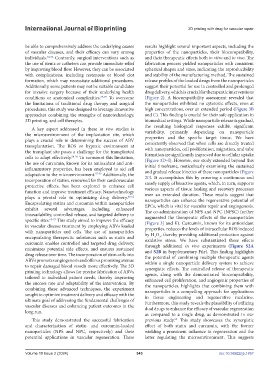Page 351 - IJB-10-2
P. 351
International Journal of Bioprinting 3D printing with drug for vascular repair
be able to comprehensively address the underlying causes results highlight several important aspects, including the
of vascular diseases, and their efficacy can vary among properties of the nanoparticles, their biocompatibility,
individuals. 74-76 Contrarily, surgical interventions such as and their therapeutic effects both in vitro and in vivo. The
the use of stents or catheters can provide immediate relief fabrication process yielded nanoparticles with consistent
by improving blood flow. However, they can be associated spherical shapes and sizes, indicating the reproducibility
with complications, including restenosis or blood clot and stability of the manufacturing method. The sustained
formation, which may necessitate additional procedures. release profiles of the loaded drugs from the nanoparticles
Additionally, some patients may not be suitable candidates suggest their potential for use in controlled and prolonged
for invasive surgery because of their underlying health drug delivery, which is crucial for therapeutic interventions
conditions or anatomical complexities. 77-79 To overcome (Figure 2). A biocompatibility assessment revealed that
the limitations of traditional drug therapy and surgical the nanoparticles exhibited no cytotoxic effects, even at
procedures, this study was designed to leverage innovative high concentrations, over an extended period (Figure 3B
approaches combining the strengths of nanotechnology, and C). This finding is crucial for their safe application in
3D printing, and cell therapies. biomedical settings. While nanoparticle release is gradual,
the resulting biological responses exhibit significant
A key aspect addressed in these in vivo studies is
the microenvironment of the implantation site, which variability, primarily depending on nanoparticle
plays a crucial role in determining the success of ABV properties and the specific target tissue. We have
transplantation. The ROS or hypoxic environment at consistently observed that when cells are directly treated
with nanoparticles, cell proliferation, migration, and tube
the transplant site poses a challenge for the transplanted formation are significantly improved due to cellular uptake
cells to adapt effectively. 54-56 To surmount this limitation, (Figure 3D–I). However, our study extended beyond this
the use of curcumin, known for its antioxidant and anti- initial timeframe, meticulously examining the sustained
inflammatory properties, has been employed to aid cell and gradual release kinetics of these nanoparticles (Figure
adaptation to the microenvironment. 57-59 Additionally, the 2F). It accomplishes this by ensuring a continuous and
incorporation of statins, renowned for their cardiovascular
protective effects, has been explored to enhance cell steady supply of bioactive agents, which, in turn, supports
various aspects of tissue healing and recovery processes
function and improve treatment efficacy. Nanotechnology over an extended duration. These results suggest that
plays a pivotal role in optimizing drug delivery. 60-62 nanoparticles can enhance the regenerative potential of
Encapsulating statins and curcumin within nanoparticles EPCs, which is vital for vascular repair and angiogenesis.
exhibit several advantages, including enhanced The co-administration of NPS and NPC (NPSC) further
bioavailability, controlled release, and targeted delivery to augmented the therapeutic effects of the nanoparticles
specific sites. 65-67 This study aimed to improve the efficacy (Figure 3J and K). Curcumin, known for its antioxidant
in vascular disease treatment by employing ABVs loaded properties, reduces the levels of intracellular ROS induced
with nanoparticles and cells. The use of nanoparticles by H O , thereby providing additional protection against
encapsulating therapeutic substances such as statin and oxidative stress. We have substantiated these effects
2
2
curcumin enables controlled and targeted drug delivery, through additional in vivo experiments (Figure S2A
minimizes potential side effects, and ensures sustained and S2B in Supplementary File). This finding highlights
drug release over time. The incorporation of stem cells into the potential of combining multiple therapeutic agents
ABVs promotes angiogenesis and offers a promising avenue within a single nanoparticle delivery system to achieve
to repair damaged blood vessels more effectively. The 3D synergistic effects. The controlled release of therapeutic
printing technology allows for precise fabrication of ABVs agents, along with the demonstrated biocompatibility,
tailored to individual patient needs, thereby improving enhanced cell proliferation, and angiogenic properties of
the success rate and adaptability of the intervention. By the nanoparticles, highlights that combining them with
combining these advanced techniques, the experiment nanoparticles is a compelling approach for applications
sought to optimize treatment delivery and efficacy with the in tissue engineering and regenerative medicine.
ultimate goal of addressing the fundamental challenges of Furthermore, this study reveals the plausibility of utilizing
vascular diseases and enhancing patient outcomes in the dual drugs to enhance the efficacy of vascular regeneration
long run.
as compared to a single drug, as demonstrated in our
This study demonstrated the successful fabrication previous study. This study showcases the synergistic
68
and characterization of statin- and curcumin-loaded effect of both statin and curcumin, with the former
nanoparticles (NPS and NPC, respectively) and their wielding a prominent influence in regeneration and the
potential applications in vascular regeneration. These latter regulating the microenvironment. This suggests
Volume 10 Issue 2 (2024) 343 doi: 10.36922/ijb.1857

